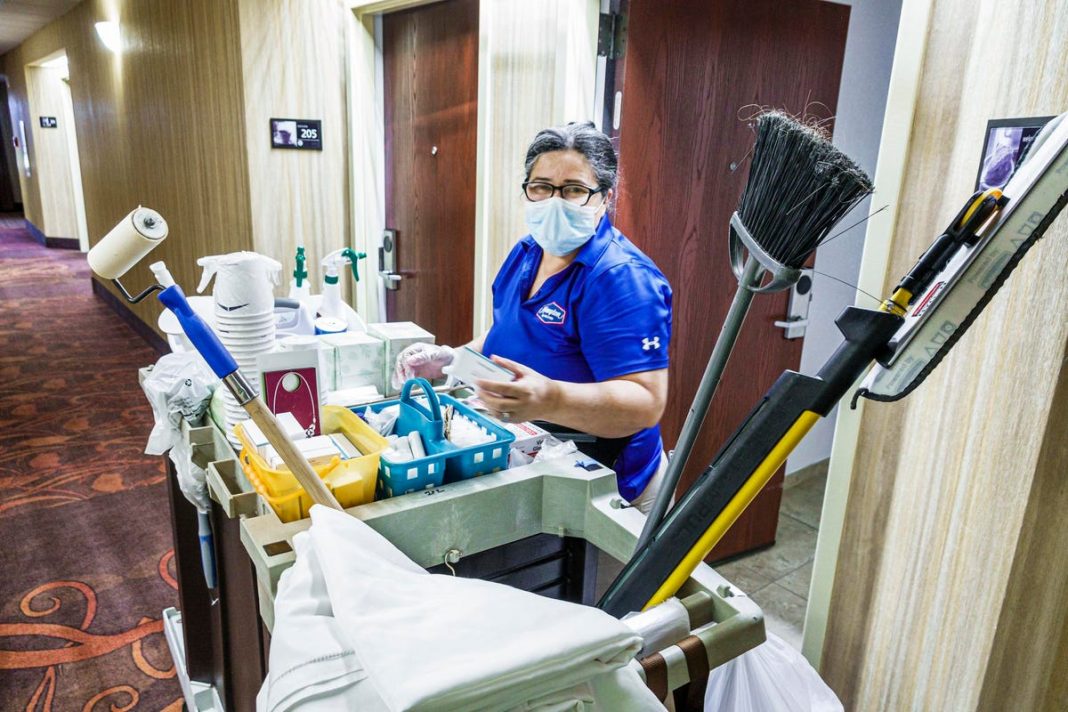Florida, Hampton Inn by Hilton, hotel housekeeper cleaning staff wearing face mask. (Photo by: … [+]
Universal Images Group via Getty Images
Women study, earn, and work more than they did 100 years ago – a sign of progress in the fight against sex discrimination. However, women with equivalent skills and education still earn less than men, which adds up to much worse retirement security in old age.
As a result of lower lifetime earnings, lower retirement savings and longer life expectancy, more than half of American women over 65 are economically vulnerable and much more likely to fall into poverty.
Let’s celebrate the progress. The World Economic Forum’s Global Gender Gap Report finds women and men education gap closing everywhere with no difference between American men and women. But education isn’t everything. Men and women take out similar loans and pay the same tuition but when they graduate and hit the labor market, pay for the same and comparable work puts women behind at the very beginning. In 2020, women only received 84% of men’s median hourly earnings in the United States.
Barbara Schuster, PhD economics student at The New School helped me with this report. We note adding injury to the women’s lower pay is that women also have an unequal burden of unpaid work — work at zero pay. Women in the US spend almost twice as much time as men doing unpaid domestic chores. And parenthood costs women more. Men tend to receive a parent premium; women pay a “mother” tax. The unequal economic consequences of parenthood is caused partly by working hours changes after childbirth. Fathers increase their working hours, whereas mothers tend to reduce their time in paid work leading to a life with interrupted career paths, part-time work or employment in more flexible low-wage occupations rather than management positions. Additionally, progressive income taxation of family income discourages married women from joining the labor force, but it is a small factor compared to inadequate childcare.
Economists decompose all these factors to identify which matter more in causing the gender pay gap — and the biggest ones are women’s occupations pay less, women trim their hours to take care of family, and employers still pay less to women because they think they are less valuable and women will accept the lower pay.
What people might not realize is how decades of lower earnings mean lower contributions to Social Security and retirement accounts, which translates into less retirement savings.
However, not only Social Security benefits are affected by lower lifetime earnings, but also retirement wealth accumulated via employer-sponsored retirement plans. For the few who have defined benefit plans where benefits are based on job tenure and salary, workers reaping the highest benefits have long, uninterrupted careers. Of workers with retirement plans, and about half do not have anything, most have 401(k) type plans. Women are disadvantaged with that design also because those with the highest benefits and less leakage between job changes are people with long standing secure jobs with fewer breaks in service, which is more the typical male than female career path.
. The consequence of lower retirement savings for women is substantial, since women’s life expectancy is longer and they have to make do with their savings over a longer period of time. Furthermore, women tend to retire at a younger age than men, because often spouses retire at the same time and women are usually the younger partner.
Early retirements negatively affect women’s retirement security, and thus working longer has larger benefits for women than for men. This increases women’s willingness to work longer, so that they have more time to accumulate retirement wealth – however, the Covid-19 pandemic triggered 1.7 million involuntary retirements and age discrimination also presents an obstacle for women who want to work longer.
The negative effects of discrimination women face on the labor market last a lifetime. Therefore, in order to fix the gender inequalities in the retirement system one has to start with changes to labor market policies and practices.
Policy measures should lower obstacle to women working for pay: institute a robust federal paid family and medical leave program and affordable childcare — perhaps a longer school day and longer school year. A triple win for students, parents, and the majority female workers in schools.
Another possibility is to offer a Social Security caregiver credit, which would provide financial compensation upon retirement for those who left the workforce to care for family members. More ideas and resources can be found at my go to place for gender equity for women, Women’s Institute for a Secure Retirement with a memorable acronym — WISER.




